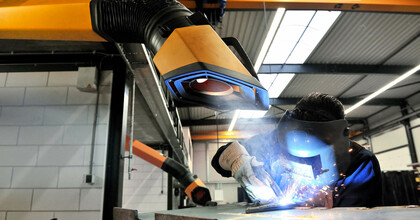Welding of stainless steel is a common process, which has increasing raised concerns for the working environment. Chromium is next to nickel one of the basic alloy element of all groups of stainless steels. During the welding process, chromium is converted to its hexavalent state, Chromium (VI).
The production of these elements occurring in stainless steel welding fume is believed to have serious effects on the health of welders and people in the welding environment. Cr(VI) fume is highly toxic and can damage the eyes, skin, nose, throat, and lungs and is carcinogenic.
Methods and fume production
The amounts of fumes released during the welding of stainless steel depend largely on the welding method used. The most common methods are:
- Tungsten Inert Gas (TIG)
- Metal Inert Gas / Metal Active Gas (MIG/MAG)
About 80% of welding operations use this method:
and 5% specialist companies uses for specific applications:
TIG produces the least fume although it does produce significant amounts of ozone and nitrous oxide both of which are irritant gases. MIG and MAG generally produce quite a lot more fume. MMA welding and FCA tend to produce the most fumes.
About 60% of companies take no preventative measures
Surveys in Great Britain and the USA indicate that one third of welding companies protect their welders against fumes from welding stainless steel with proper and professional ventilation systems. This means that more than 60% of the companies should address this issue and carry out risk assessments with a specialist in ventilation systems and personal protection equipment to improve the working conditions of welders and protect their health.
Be aware of the risks
“As a welder you should also be aware of the risks of welding stainless steel”, warns the American specialist Vicki Bell in several publications. “Before beginning a welding job, it is important to identify the hazards for the particular welding operation. The hazards will depend on the type of welding, the materials (base metals, surface coatings, electrodes) to be welded and the environmental conditions (outside or in a confined space).”
Advice
She is also very clear in her advice. “Ask for a material safety data sheet (MSDS) to identify the hazardous materials used in welding products and the fumes that may be generated. Make sure you know what you are welding before you start. Some fumes, such as those released from welding on a cadmium-plated surface, can be fatal in a short time. After identifying the hazard, implement appropriate control methods.”
Adequate ventilation needed
“Use adequate ventilation. Local exhaust ventilation, which removes fumes and gases at the source, is the most effective method. Use a partial enclosure, such as a ventilated workbench, or extraction arm positioned as close to the point of welding as possible. Clean and maintain ventilation systems regularly."
It is also important to replace filters in-time, preferably with an original filter cartridge. Our filters are carefully matched to our systems. With that combination we can ensure our customers that they get the very best systems.




